Glycolysis pt1
1/38
There's no tags or description
Looks like no tags are added yet.
Name | Mastery | Learn | Test | Matching | Spaced |
|---|
No study sessions yet.
39 Terms
Glycolysis preparatory phase
ATP is consumed
∆G of the intermediates increases
hexose carbon chains are converted to glyceraldehyde 3-phosphate
payoff phase
energy conserved as 2 ATP and 2 NADH
2 pyruvate
Noteworthy Chemical Transformations of Glycolysis
degradation of the carbon skeleton of glucose to yield pyruvate
phosphorylation of ADP to ATP by compounds with high phosphoryl group transfer potential, formed during glycolysis
transfer of a hydride ion to NAD+, forming NADH
Resolving the Equation of Glycolysis into Two Processes
the conversion of glucose to pyruvate is exergonic:
glucose + 2NAD+ ——>2 pyruvate + 2NADH + 2H+
∆G′°1 = −146 kJ/mol
the formation of ATP from ADP and Pi is endergonic:
2ADP + 2Pi ——→ 2ATP + 2H2O
∆G′°2 = 2(30.5 kJ/mol) = 61.0 kJ/mol
Standard Free-Energy Change of Glycolysis
under standard and cellular conditions, glycolysis is essentially irreversible because payoff phase is much higher in magnitude than investment
Energy Remaining in Pyruvate
energy stored in pyruvate can be extracted by:
aerobic processes:
oxidative reactions in the citric acid cycle
oxidative phosphorylation
anaerobic processes
reduction to lactate
reduction to ethanol
Importance of Phosphorylated Intermediates
all nine intermediates are phosphorylated
functions of the phosphoryl groups:
prevent glycolytic intermediates from leaving the cell
serve as essential components in the enzymatic conservation of metabolic energy
lower the activation energy and increase the specificity of the enzymatic reactions
The Preparatory Phase of Glycolysis Requires ATP
two molecules of ATP are invested to activate glucose to fructose 1,6-bisphosphate
the bond between C-3 and C-4 of fructose 1,6-bisphosphate is then broken to yield two molecules of triose phosphate
Phosphorylation of Glucose STEP 1
hexokinase activates glucose by phosphorylating at C-6 to yield glucose 6-phosphate
ATP serves as the phosphoryl donor
hexokinase requires Mg2+ for its activity
irreversible under intracellular conditions
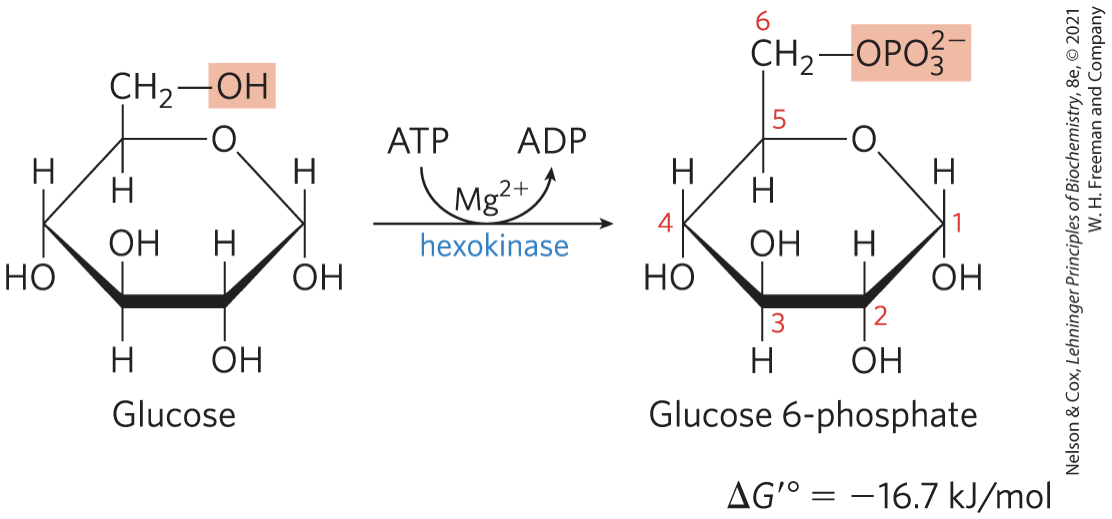
Conversion of Glucose 6-Phosphate to Fructose 6-Phosphate STEP 2
phosphohexose isomerase (phosphoglucose isomerase) catalyzes the reversible isomerization of glucose 6-phosphate to fructose 6-phosphate
mechanism involves an enediol intermediate
reaction readily proceeds in either direction
reversible
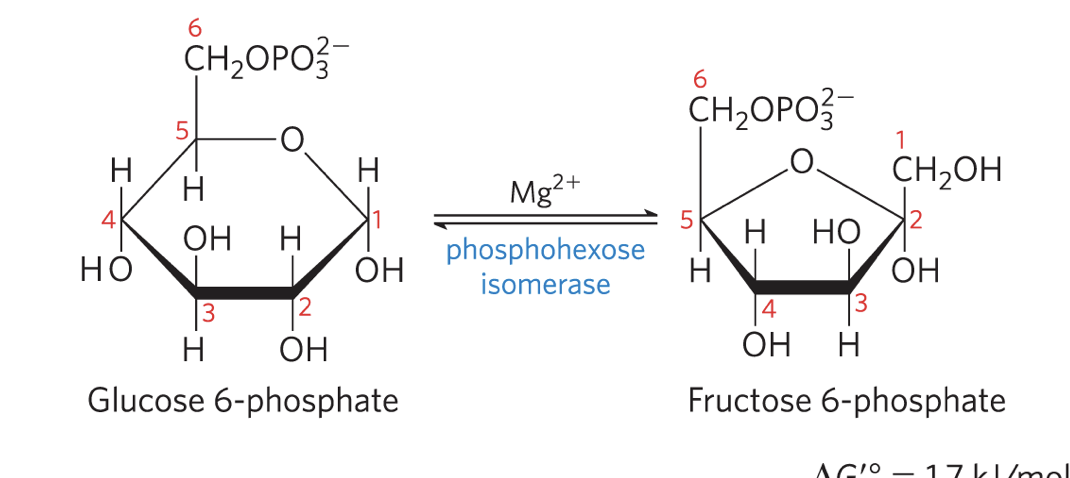
Phosphorylation of Fructose 6-Phosphate to Fructose 1,6-Bisphosphate STEP 3
phosphofructokinase-1 (PFK-1) catalyzes the phosphorylation of fructose 6-phosphate to yield fructose 1,6-bisphosphate
irreversible
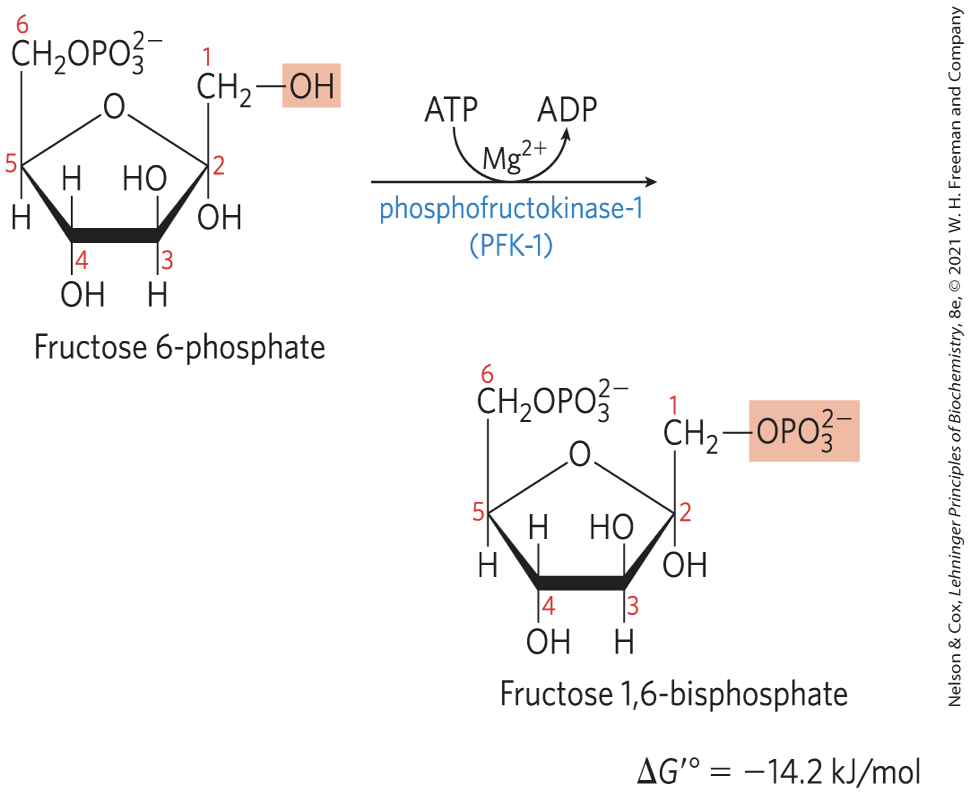
Cleavage of Fructose 1,6-Bisphosphate STEP 4
aldolase
yield glyceraldehyde 3-phosphate and dihydroxyacetone phosphate
reversible because reactant concentrations are low in the cell
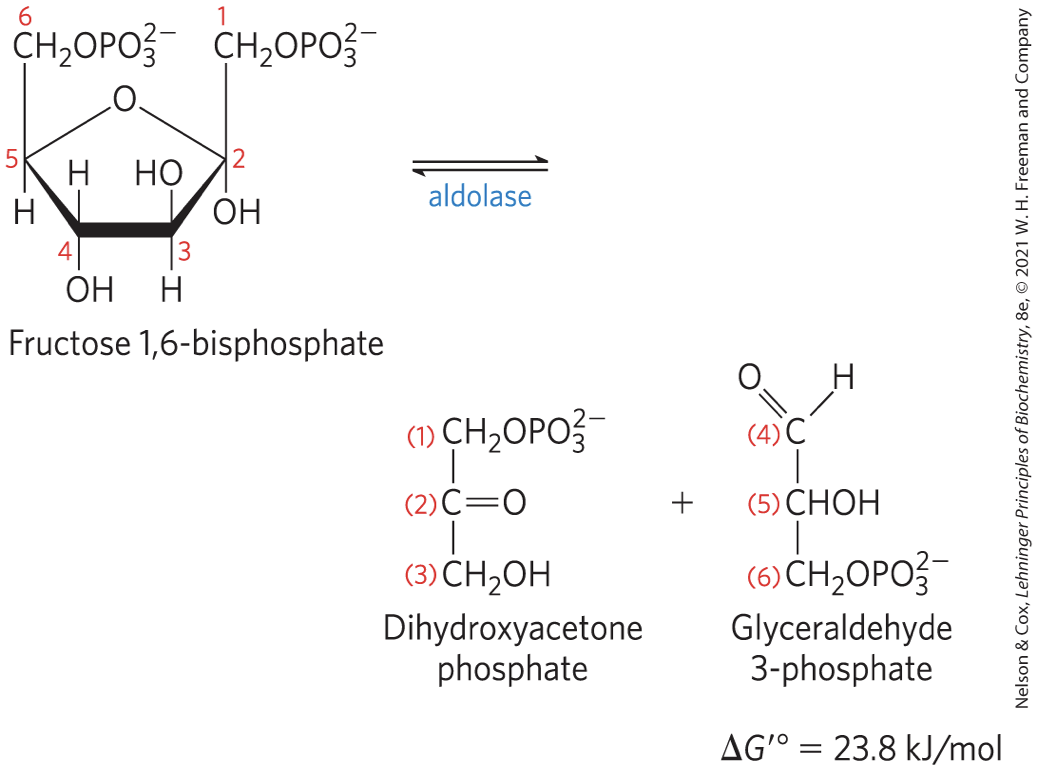
Interconversion of the Triose Phosphates STEP 5
triose phosphate isomerase converts dihydroxyacetone phosphate to glyceraldehyde 3-phosphate
reversible
final step of the preparatory phase of glycolysis

in the payoff phase of glycolysis…
each of the two molecules of glyceraldehyde 3-phosphate undergoes oxidation at C-1
some energy from the oxidation reaction is conserved in the form of one NADH and two ATP per triose phosphate oxidized
Oxidation of Glyceraldehyde 3-Phosphate to 1,3-Bisphosphoglycerate STEP 6
glyceraldehyde 3-phosphate dehydrogenase catalyzes the oxidation glyceraldehyde 3-phosphate to 1,3-bisphosphoglycerate
energy-conserving reaction
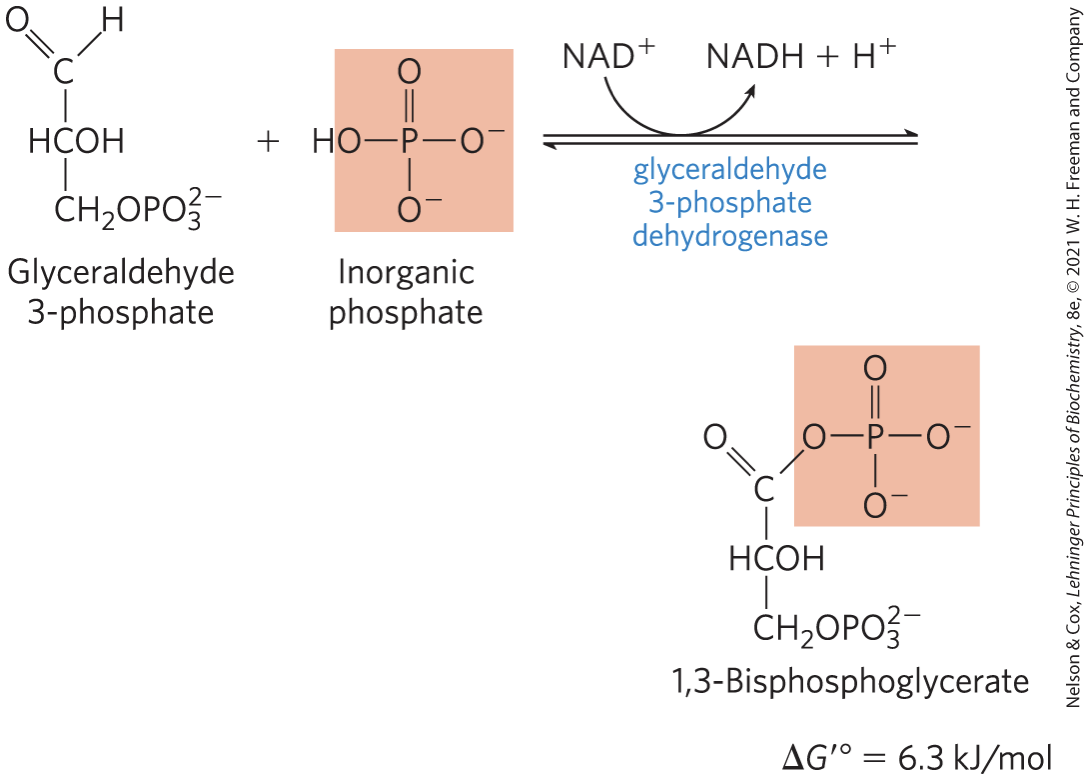
The First Step of the Payoff Phase is an Energy-Conserving Reaction
formation of the acyl phosphate group at C-1 of 1,3-bisphosphoglycerate conserves the free energy of oxidation
acyl phosphates have a very high standard free energy of hydrolysis (∆G′° = −49.3 kJ/mol)
Phosphoryl Transfer from 1,3-Bisphosphoglycerate to ADP STEP 7
phosphoglycerate kinase transfers the high-energy phosphoryl group from the carboxyl group of 1,3-bisphosphoglycerate to ADP
forming ATP and 3-phosphoglycerate
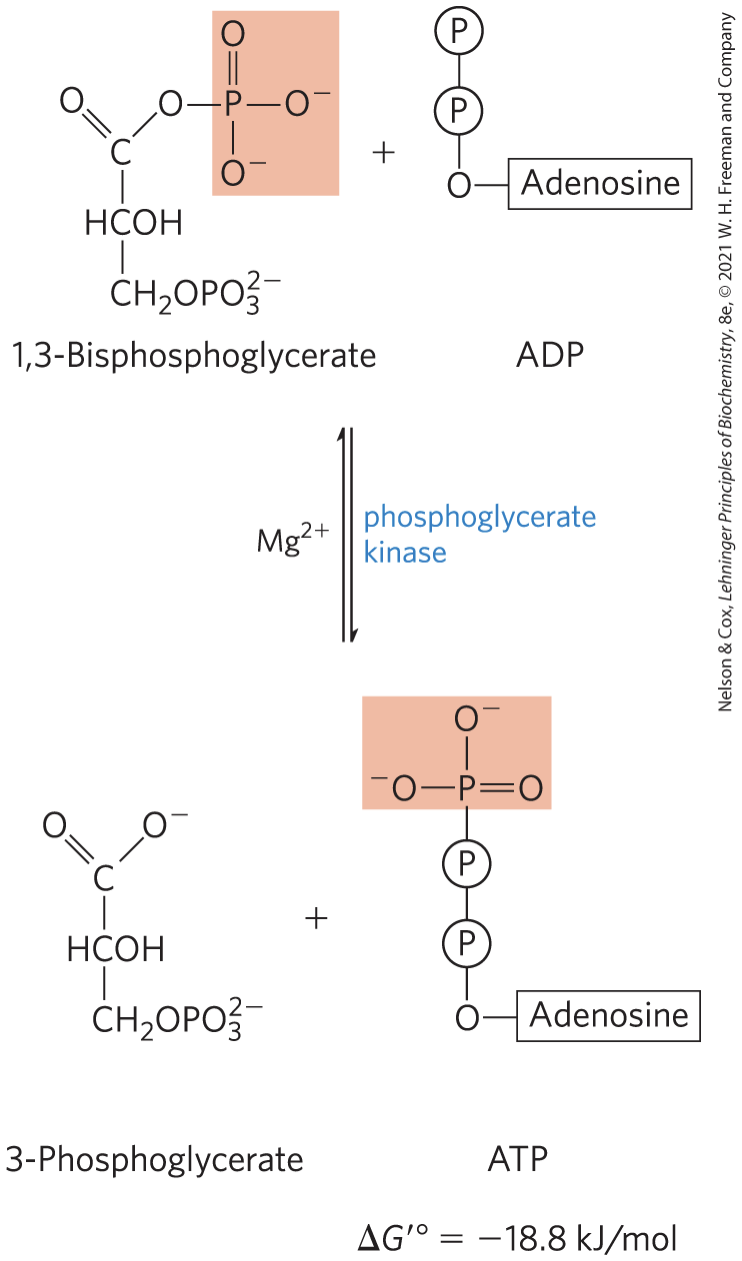
Steps 6 and 7 of Glycolysis Constitute an ______ Process
Energy coupling. deltaG 6-18
substrate-level phosphorylation
the formation of ATP by phosphoryl group transfer from a substrate
Conversion of 3-Phosphoglycerate to 2-Phosphoglycerate STEP 8
phosphoglycerate mutase catalyzes a reversible shift of the phosphoryl group between C-2 and C-3 of glycerate
requires Mg2+
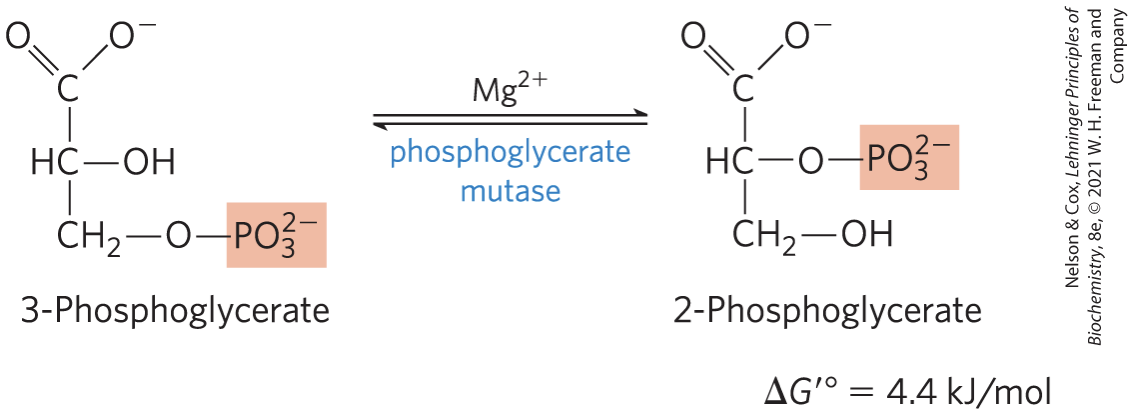
Dehydration of 2-Phosphoglycerate to Phosphoenolpyruvate STEP 9
enolase promotes reversible removal of a molecule of water from 2-phosphoglycerate to yield phosphoenolpyruvate (PEP)
energy-conserving reaction
mechanism involves a Mg2+-stabilized enolic intermediate
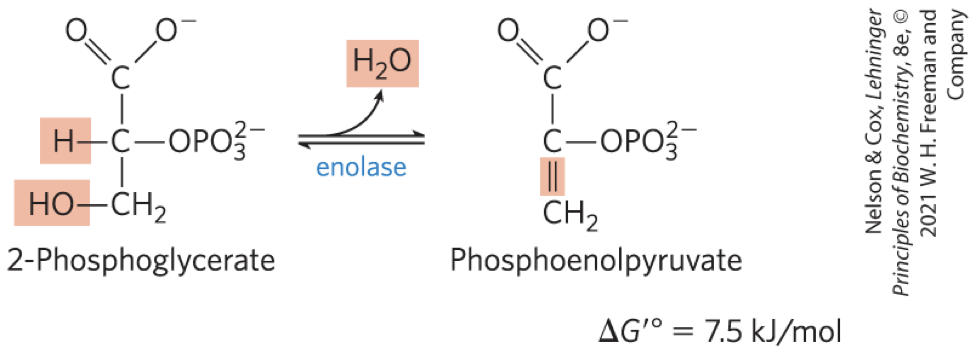
Transfer of the Phosphoryl Group from Phosphoenolpyruvate to ADP STEP 10
pyruvate kinase catalyzes the transfer of the phosphoryl group from phosphoenolpyruvate to ADP, yielding pyruvate
requires K+ and either Mg2+ or Mn2+
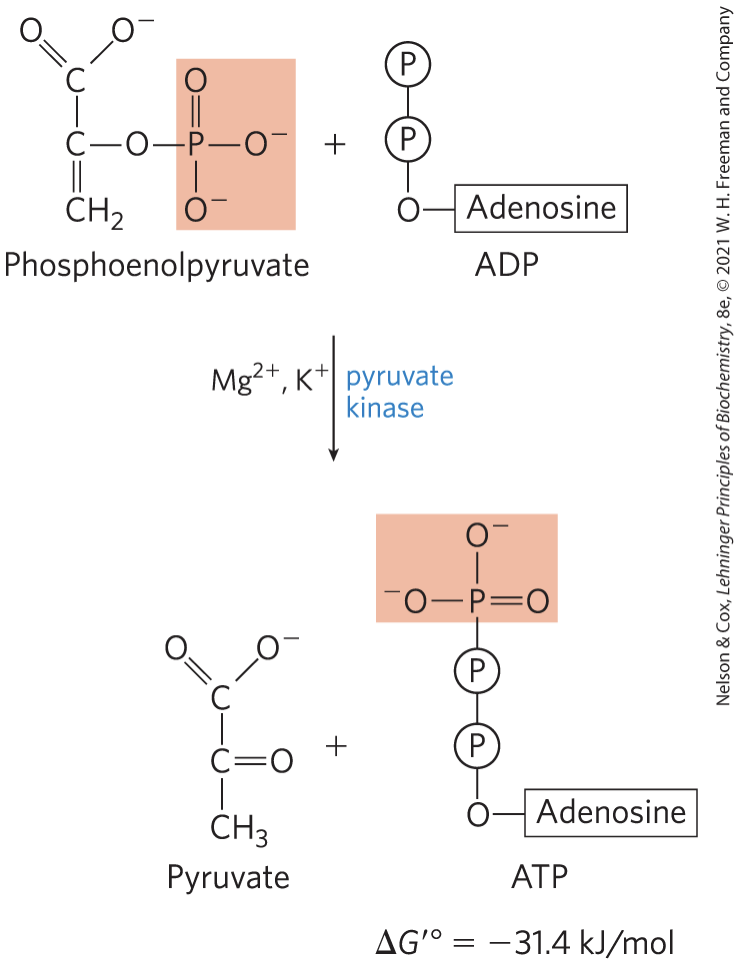
Pyruvate in its Enol Form Spontaneously
Tautomerizes to its Keto Form
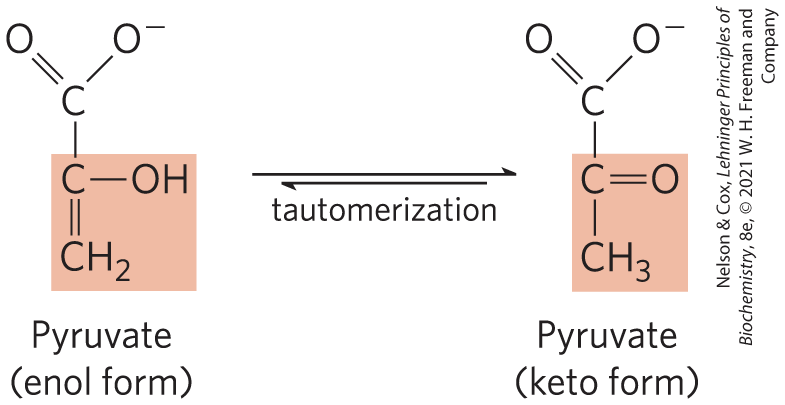
Overall Reaction of Glycolysis
to Net Reaction

The Overall Balance Sheet Shows a Net ____
Gain of Two ATP and Two NADH Per Glucose
Endogenous Glycogen and Starch Are Degraded by Phosphorolysis
glycogen phosphorylase = mobilizes glycogen stored in animal tissues and microorganisms by a phosphorolytic reaction to yield glucose 1-phosphate
starch phosphorylase = mobilizes starch by a phosphorolytic reaction
Glycogen Breakdown Is Catalyzed by Glycogen Phosphorylase
glycogen phosphorylase = catalyzes phosphorolytic cleavage at the nonreducing ends of glycogen chains
requires pyridoxal phosphate
acts repetitively until it reaches a point four residues away from a (α1→6) branch point
Debranching Enzyme
debranching enzyme = transfers branches onto main chains and releases the residue at the (α1→6) branch as free glucose
Phosphoglucomutase
catalyzes the reversible reaction glucose 1-phosphate ←→glucose 6-phosphate
glucose 6-phosphate can continue through glycolysis or enter another pathway
mutase
enzyme that catalyzes the transfer of a functional group from one position to another in the same molecule
—subclass of isomerases
Dietary Polysaccharides and Disaccharides
salivary and small intestine enzyme that hydrolyzes the internal (α1→4) glycosidic linkages of starch and glycogen, producing di- and trisaccharides
pancreatic α-amylase yields mainly ____
maltose, maltotriose, and limit dextrins (fragments of amylopectin containing (α1→6) branch points, which are removed by limit dextrinases)
Hydrolysis of Disaccharides
membrane-bound hydrolases in the intestinal brush border hydrolyze disaccharides:
monosaccharides pass through intestinal cells to the bloodstream, which transports them to the liver or other tissues
Cellulase
attacks the (β1→4) glycosidic bonds of cellulose
absent in most animals
microorganisms produce cellulase
Lactose Digestion and Lactose Intolerance
lactase = converts lactose to glucose and galactose
present in infants but often absent in adults, producing lactose intolerance
lactase persistence phenotype = production of lactase into adulthood
lactose intolerance = inability to digest lactose due to the disappearance of lactase in adulthood
causes abdominal cramps and diarrhea
Fructose and Mannose
fructose and mannose can be phosphorylated and funneled into glycolysis
hexokinase = phosphorylates fructose in the small intestine
fructose kinase = phosphorylates fructose in the liver

Fructose 1-Phosphate Aldolase
fructose 1-phosphate aldolase = cleaves fructose 1-phosphate to glyceraldehyde and dihydroxyacetone
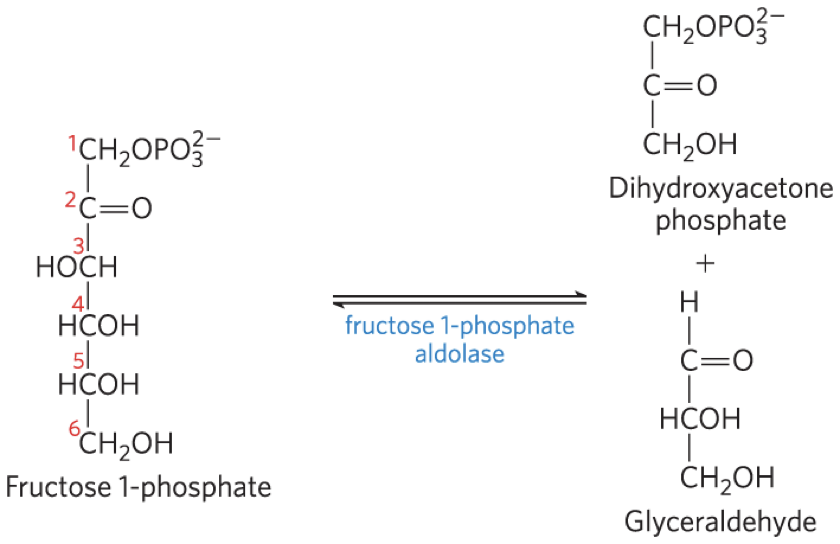
Products of Fructose 1-Phosphate Hydrolysis Enter Glycolysis as
Glyceraldehyde 3-Phosphate
triose phosphate isomerase = converts dihydroxyacetone phosphate to glyceraldehyde 3-phosphate
triose kinase = uses ATP to phosphorylate glyceraldehyde to glyceraldehyde 3-phosphate

Mannose Enters Glycolysis as
Fructose 6-Phosphate
hexokinase = phosphorylates mannose at C-6
phosphohexose isomerase = converts mannose 6-phosphate to fructose 6-phosphate
